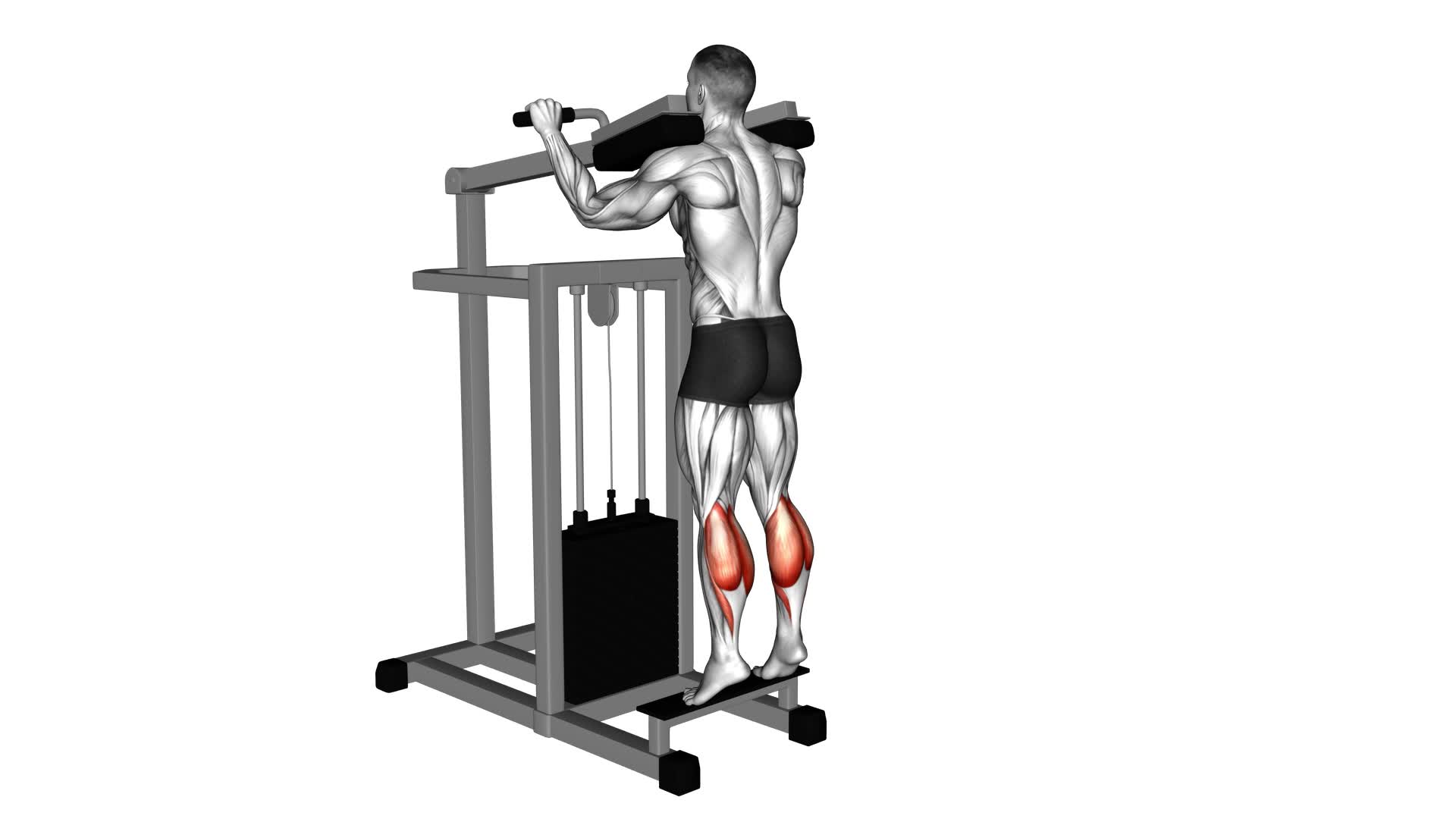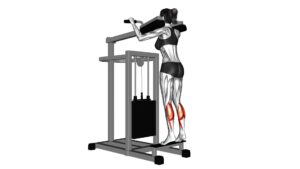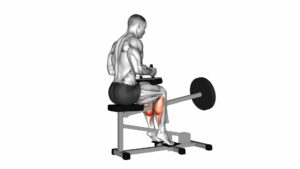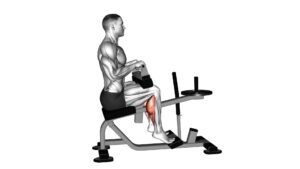Lever Standing Calf Raise – Video Exercise Guide & Tips

Are you looking to strengthen and tone your calves? Look no further than the lever standing calf raise!
Watch This Exercise Video
This exercise targets your calf muscles and can be done using a lever machine.
In this video exercise guide, we'll show you the proper form and technique, as well as tips to make the most of your calf workout.
Get ready to rock those shorts with confidence!
Key Takeaways
- Lever Standing Calf Raise targets calf muscles for strength and definition.
- Proper form and technique, such as maintaining a controlled and upright posture, is crucial for effective execution.
- Adjusting the lever machine, including setting the lever height and foot position, enhances the effectiveness of standing calf raises.
- Finding optimal resistance and variations, such as single-leg calf raises or weighted calf raises, allows for progression and muscle fatigue management.
Benefits of Lever Standing Calf Raise
You can experience several benefits from incorporating the lever standing calf raise into your workout routine.
This exercise specifically targets your calf muscles, helping you to develop strength and definition in this area. By regularly performing the lever standing calf raise, you can increase the size and power of your calf muscles, which can improve your overall athletic performance.
Strong calf muscles are essential for activities such as running, jumping, and even walking, as they provide stability and propulsion. Additionally, strong calves can help prevent injuries, such as calf strains or Achilles tendonitis.
The lever standing calf raise also promotes better balance and stability, as it requires you to maintain a controlled and upright posture while performing the exercise. This can have a positive impact on your overall coordination and body control.
Furthermore, the lever standing calf raise can be easily modified to accommodate different fitness levels, making it suitable for beginners and advanced athletes alike.
Incorporating this exercise into your routine can provide you with the benefits of stronger calf muscles, improved athletic performance, enhanced balance and stability, and reduced risk of injury.
Proper Form and Technique
To perform the lever standing calf raise with proper form and technique, it's important to consistently maintain a controlled and upright posture throughout the exercise. This will help you maximize the benefits of the exercise and avoid unnecessary strain or injury. Here are some key points to keep in mind:
- Importance of posture:
- Stand tall with your feet shoulder-width apart and your core engaged.
- Keep your shoulders back and your chest lifted throughout the exercise.
- Avoid rounding your shoulders or hunching forward, as this can put undue stress on your spine.
- Benefits of controlled movement:
- Lift your heels off the ground slowly and with control.
- Pause briefly at the top of the movement to fully contract your calf muscles.
- Lower your heels back down slowly and avoid any jerking or bouncing motions.
- Technique tips for proper execution:
- Focus on pushing through the balls of your feet to engage your calf muscles.
- Keep your knees straight throughout the exercise.
- Breathe steadily and avoid holding your breath.
By following these guidelines and maintaining proper form and technique, you can maximize the effectiveness of the lever standing calf raise and avoid any potential injuries.
Adjusting the Lever Machine
To properly adjust the lever machine for the standing calf raise, start by setting the lever height at a level that allows your feet to be flat on the footplate when standing.
Next, adjust your foot position so that the balls of your feet are securely on the footplate and your heels are slightly hanging off.
Finally, find the optimal resistance by selecting a weight that challenges your calf muscles but still allows you to maintain proper form and complete the desired number of repetitions.
Proper Lever Height
Adjusting the lever machine to the proper height is key for performing the standing calf raise exercise correctly. By ensuring the lever angle and position are correct, you can target the calf muscles effectively and minimize the risk of injury.
Here are some tips to help you adjust the lever machine to the proper height:
- Start by standing on the machine with your toes on the footplate and your heels hanging off the edge.
- Adjust the lever height so that it aligns with the balls of your feet.
- Make sure the lever is parallel to your ankle joint to maintain proper alignment.
- Avoid setting the lever too high or too low, as it can lead to ineffective calf activation or strain on other muscles.
Adjusting Foot Position
You should frequently check and adjust your foot position on the lever machine to ensure proper alignment and maximize the effectiveness of the standing calf raise exercise. Proper foot placement is crucial for activating the calf muscles correctly and avoiding unnecessary strain on other muscle groups.
To begin, position your feet shoulder-width apart on the platform, ensuring that your toes are pointing forward. This alignment will target the calf muscles directly. If you want to target different areas of the calves, you can adjust your foot position by pointing your toes inward or outward slightly.
Experiment with different foot placements to find the position that works best for you and provides the most calf muscle activation. Remember, proper foot placement will enhance the effectiveness of your standing calf raises and help you achieve optimal results.
Finding Optimal Resistance
To ensure maximum effectiveness of the lever standing calf raise exercise, it's important to adjust the resistance on the lever machine. Finding the optimal weight for your workout can make a big difference in the results you achieve.
Here are three tips to help you find the right resistance:
- Start with a lighter weight: Begin with a weight that feels challenging but manageable. This will allow you to focus on proper form and technique without straining your muscles too much.
- Increase gradually: As you become more comfortable with the exercise, gradually increase the resistance. This will help you continue challenging your muscles and making progress.
- Listen to your body: Pay attention to how your muscles feel during the exercise. If the weight feels too easy, it may be time to increase it. On the other hand, if it feels too difficult and you're unable to complete the desired number of repetitions, consider decreasing the resistance.
Variations and Progressions
Now that you've mastered the basics of the lever standing calf raise, it's time to take your calf exercises to the next level with variations and progressions.
These advanced exercises will challenge your calf muscles even more and help you continue to build strength and size.
As you progress, gradually increase the weight to continue challenging your muscles and promoting growth.
Get ready to step up your calf game and see even better results.
Advanced Calf Exercises
To progress your calf exercises further, incorporate variations and progressions. This will help you take your advanced calf training to the next level and achieve optimal calf muscle development.
Here are three effective variations and progressions to consider:
- Single-Leg Calf Raises: Perform calf raises on one leg at a time to increase the intensity and challenge your balance and stability.
- Plyometric Calf Jumps: Incorporate explosive jumps into your calf exercises to enhance power and explosiveness in your calf muscles.
- Calf Raises with Weight: Hold dumbbells or use a calf raise machine to add resistance and increase the load on your calf muscles, promoting strength and muscle growth.
Increasing Weight Gradually
Gradually increase the weight you use for the lever standing calf raise exercise to challenge your calf muscles and promote strength and muscle growth. The key to achieving optimal results is through gradual progression and weight increments.
Start with a weight that allows you to complete the exercise with proper form and control. As your calf muscles adapt and become stronger, gradually increase the weight in small increments. This progressive overload stimulates muscle growth and helps prevent plateaus.
Aim to increase the weight by 5-10% each week or whenever you can complete the desired number of repetitions comfortably. Remember to listen to your body and avoid excessive weight increases that could lead to injury.
By gradually increasing the weight, you'll continue to challenge your calf muscles and see continued progress in strength and muscle growth.
Now, let's move on to the next section and discuss common mistakes to avoid.
Common Mistakes to Avoid
Are you unknowingly making common mistakes while performing the Lever Standing Calf Raise exercise? Avoiding these mistakes is crucial to prevent injuries and ensure you're effectively improving your calf strength. Here are some common mistakes to avoid:
- Using too much weight: Using excessive weight can put unnecessary strain on your calf muscles and increase the risk of injury. Start with a lighter weight and gradually increase it as you build strength.
- Not maintaining proper form: It's important to maintain proper form throughout the exercise to target the calf muscles effectively. Avoid leaning forward or using momentum to lift the weight. Keep your back straight and engage your core muscles.
- Neglecting the full range of motion: To maximize the benefits of the Lever Standing Calf Raise, make sure you go through the full range of motion. Lower your heels as far as possible without lifting your toes off the platform, and then lift your heels as high as you can.
Tips for an Effective Calf Workout
Now let's focus on how you can maximize the effectiveness of your calf workout with these tips.
One important aspect to consider is calf muscle activation. To ensure that you're effectively targeting your calf muscles during your workout, it's crucial to maintain proper form and technique. Make sure to fully extend your ankles during exercises such as calf raises, as this will engage the calf muscles more effectively.
Additionally, incorporating stretching exercises for calves into your routine can help improve flexibility and prevent muscle imbalances. Try performing standing calf stretches or seated calf stretches to stretch the muscles before and after your workout. This won't only help improve your range of motion but also reduce the risk of injury. Remember to hold each stretch for at least 30 seconds and breathe deeply to allow the muscles to relax and lengthen.
Frequently Asked Questions
How Much Weight Should I Start With When Performing the Lever Standing Calf Raise?
When performing the lever standing calf raise, it's important to start with an appropriate amount of weight. To determine your starting weight, consider your current strength and fitness level.
It's crucial to maintain proper form throughout the exercise, so choose a weight that allows you to perform the movement correctly. Starting with too much weight can lead to improper form and potential injury.
Start with a manageable weight and gradually increase as you become more comfortable and proficient.
Can I Perform the Lever Standing Calf Raise if I Have a Knee Injury?
If you have a knee injury, it's important to be cautious when performing the lever standing calf raise. This exercise puts pressure on the knees, so it may not be the best option for you.
Instead, try calf raise modifications or alternative exercises that are easier on your joints. It's always better to prioritize your safety and find exercises that work for your specific condition.
How Often Should I Incorporate the Lever Standing Calf Raise Into My Workout Routine?
To optimize your calf gains, it's important to incorporate the lever standing calf raise into your workout routine. The optimal frequency for this exercise is 2-3 times a week.
This will allow your calf muscles enough time to recover and grow stronger. By adding the lever standing calf raise to your well-rounded workout routine, you'll target the calves specifically, helping to build strength and definition in this area.
Are There Any Specific Footwear Recommendations for Performing the Lever Standing Calf Raise?
When performing the lever standing calf raise, it's important to wear appropriate footwear. The right shoes can provide stability and support, ensuring proper form and reducing the risk of injury. Look for shoes with a firm sole and good arch support.
Avoid shoes with a high heel or excessive cushioning, as these can throw off your balance.
Is It Necessary to Use the Lever Machine for the Standing Calf Raise, or Can I Achieve Similar Results With Other Equipment?
You may be wondering if you can achieve similar results with other equipment instead of using the lever machine for the standing calf raise.
While there are alternative equipment options available, it's worth considering the benefits of the lever machine.
It provides a stable and controlled movement, allowing you to isolate and target your calf muscles effectively.
This can lead to better muscle activation and overall calf development.
Conclusion
Incorporating the lever standing calf raise into your workout routine can help strengthen and tone your calf muscles.
By using proper form and technique, adjusting the lever machine appropriately, and avoiding common mistakes, you can maximize the benefits of this exercise.
Don't forget to vary your calf raises and challenge yourself with progressions to keep your muscles engaged.
Follow these tips for an effective calf workout and watch your calf muscles become stronger and more defined.

Author
Years ago, the spark of my life’s passion ignited in my mind the moment I stepped into the local gym for the first time. The inaugural bead of perspiration, the initial endeavor, the very first surge of endorphins, and a sense of pride that washed over me post-workout marked the beginning of my deep-seated interest in strength sports, fitness, and sports nutrition. This very curiosity blossomed rapidly into a profound fascination, propelling me to earn a Master’s degree in Physical Education from the Academy of Physical Education in Krakow, followed by a Sports Manager diploma from the Jagiellonian University. My journey of growth led me to gain more specialized qualifications, such as being a certified personal trainer with a focus on sports dietetics, a lifeguard, and an instructor for wellness and corrective gymnastics. Theoretical knowledge paired seamlessly with practical experience, reinforcing my belief that the transformation of individuals under my guidance was also a reflection of my personal growth. This belief holds true even today. Each day, I strive to push the boundaries and explore new realms. These realms gently elevate me to greater heights. The unique combination of passion for my field and the continuous quest for growth fuels my drive to break new ground.



